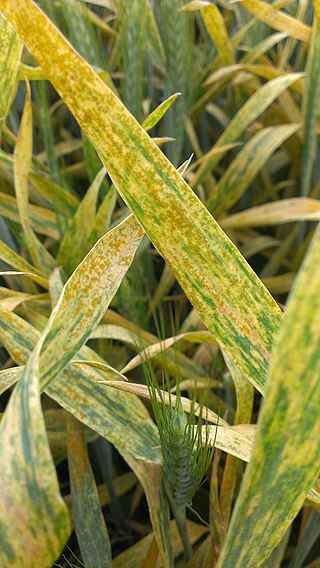
Wheat is a grass widely cultivated for its seed, a cereal grain that is a staple food around the world. The many species of wheat together make up the genus Triticum ; the most widely grown is common wheat. The archaeological record suggests that wheat was first cultivated in the regions of the Fertile Crescent around 9600 BC. Botanically, the wheat kernel is a caryopsis, a type of fruit.

Sinterklaas or Sint-Nicolaas is a legendary figure based on Saint Nicholas, patron saint of children. Other Dutch names for the figure include De Sint, De Goede Sint and De Goedheiligman. Many descendants and cognates of "Sinterklaas" or "Saint Nicholas" in other languages are also used in the Low Countries, nearby regions, and former Dutch colonies.

Wheat leaf rust is a fungal disease that affects wheat, barley, rye stems, leaves and grains. In temperate zones it is destructive on winter wheat because the pathogen overwinters. Infections can lead up to 20% yield loss. The pathogen is a Puccinia rust fungus. It is the most prevalent of all the wheat rust diseases, occurring in most wheat-growing regions. It causes serious epidemics in North America, Mexico and South America and is a devastating seasonal disease in India. P. triticina is heteroecious, requiring two distinct hosts.

Elvin Charles Stakman was an American plant pathologist who was a pioneer of methods of identifying and combatting disease in wheat. He became an internationally renowned phytopathologist for his studies of the genetics and epidemiology of stem rust. Stakman is credited with improving crop yields both in North America and worldwide as part of the Green Revolution.
Subrahmaniam Nagarajan was an Indian wheat pathologist. He studied in Chennai till high school and completed his early education at the Agriculture College, Coimbatore, then pursued his masters at the Indian Agriculture Research Institute, New Delhi and received his doctorate in Agriculture from the Delhi University. He is the Project Director of the All India Wheat program and author of more than 120 research papers, 50 book chapters and two textbooks.

Ug99 is a lineage of wheat stem rust, which is present in wheat fields in several countries in Africa and the Middle East and is predicted to spread rapidly through these regions and possibly further afield, potentially causing a wheat production disaster that would affect food security worldwide. In 2005 the noted green revolution pioneer Norman Borlaug brought great attention to the problem, and most subsequent efforts can be traced to his advocacy. It can cause up to 100% crop losses and is virulent against many resistance genes which have previously protected wheat against stem rust.

Jan Ritzema Bos was a Dutch plant pathologist and zoologist. He served as the first director of the Willie Commelin Scholten Foundation and founder of the Plant Protection Service in 1899 in Amsterdam. Bos described several species of plant nematode.

Lawrence Ogilvie was a Scottish plant pathologist who pioneered the study of wheat, fruit and vegetable diseases in the 20th century.
Crop diversity or crop biodiversity is the variety and variability of crops, plants used in agriculture, including their genetic and phenotypic characteristics. It is a subset of a specific element of agricultural biodiversity. Over the past 50 years, there has been a major decline in two components of crop diversity; genetic diversity within each crop and the number of species commonly grown.

Wheat yellow rust, also known as wheat stripe rust, is one of the three major wheat rust diseases, along with stem rust of wheat and leaf rust.

Zwarte Piet, also known in English by the translated name Black Pete, is the companion of Saint Nicholas in the folklore of the Low Countries. Traditionally, Zwarte Piet serves as an assistant to the saint and distributes sweets and gifts to well-behaved children.
The Istituto per la Protezione delle Piante (IPP), or 'Institute of Plant Protection', is part of the Food Department of the Consiglio Nazionale delle Ricerche, an Italian government organization with the aim of supporting scientific and technological research. IPP has four bases in Italy: Turin, Florence, Portici, and Bari.
Forest pathology is the research of both biotic and abiotic maladies affecting the health of a forest ecosystem, primarily fungal pathogens and their insect vectors. It is a subfield of forestry and plant pathology.
Ruth Florence Allen (1879–1963) was an American botanist and plant pathologist and the first woman to earn her Ph.D. in botany from the University of Wisconsin. Her doctorate research focused on the reproduction and cell biology of ferns, particularly the phenomenon of apogamy. Later in her career, Allen shifted her focus to plant pathology. Her major contribution to the field of mycology was furthering the understanding of rust fungi, a group of economically important plant pathogens. Allen completed many studies on Puccinia graminis, once considered a catastrophically damaging disease-causing agent in cereal crops before the discovery of current management measures.

Jakob Eriksson was a Swedish plant pathologist, mycologist and a taxonomist. Eriksson was the first to describe the special forms within morphologically similar species of rust fungi. He has over 400 publications on studies primarily focusing on fungal pathogens at the cellular level and understanding the process of infection.
Pest risk analysis (PRA) is a form of risk analysis conducted by regulatory plant health authorities to identify the appropriate phytosanitary measures required to protect plant resources against new or emerging pests and regulated pests of plants or plant products. Specifically pest risk analysis is a term used within the International Plant Protection Convention (IPPC) and is defined within the glossary of phytosanitary terms. as "the process of evaluating biological or other scientific and economic evidence to determine whether an organism is a pest, whether it should be regulated, and the strength of any phytosanitary measures to be taken against it". In a phytosanitary context, the term plant pest, or simply pest, refers to any species, strain or biotype of plant, animal or pathogenic agent injurious to plants or plant products and includes plant pathogenic bacteria, fungi, fungus-like organisms, viruses and virus like organisms, as well as insects, mites, nematodes and weeds.
Cereal growth staging scales attempt to objectively measure the growth of cereals.
J. G. ten Houten was a Dutch plant pathologist known for founding and leading several important bodies in that subject in the Netherlands.
Egbertus "Egbert" van Slogteren was a Dutch professor of horticulture and phytopathology, known for his research on flower bulbs and diagnosis of viral diseases in plants.

Het Sinterklaasjournaal is a Dutch children's television series that has been broadcast every year since 2001 during the Sinterklaas period. The program is a fictional, children news program, in which the adventures of Sinterklaas and his Petes during their stay in the Netherlands are told. The program has been broadcast by the public broadcaster NTR on the children's channel NPO Zapp since 2010.











